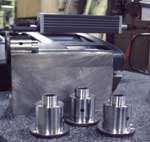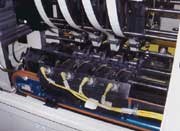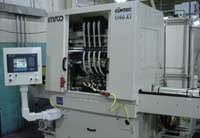Microfinishing Helps Shop Meet Demanding Specs
A high-volume auto part included specifications for something Grand Haven Steel Products (Grand Haven, Michigan) had not encountered before in its bids.
A high-volume auto part included specifications for something Grand Haven Steel Products (Grand Haven, Michigan) had not encountered before in its bids. The engine builder needed a Tp or bearing ratio for the part’s small OD. Tp is the length of a bearing surface expressed as a percentage of the total length of a sampled distance on the part surface at a depth below the highest peak. The measure is representative of the surface condition of a part after a break-in period, when the highest peaks have been worn away.
Achieving a Tp ratio is designed to eliminate the peak-and-valley tool marks that any grinding operation leaves on a workpiece,” explains Bob Lovell, president of Grand Haven Steel Products. “The reason for the spec is to allow the engine builder to eliminate the break-in period for the engine. Eliminating the peaks increases the bearing surface and permits an engine to be built to tighter tolerances. Friction is reduced, performance is improved and engine components last longer.”
Featured Content
The part the company was bidding for is a short, heat-treated, 1144 steel idler post for a timing assembly on a new V-6 engine. A bushing and a sprocket are assembled on the part’s small OD. The part has an ID and a cross-hole for lubrication. It calls for tenths tolerances and an 8-micron Ra surface finish.
Processing of the part includes roughing it out from barstock on multi-spindle automatics, drilling the cross hole, heat treating, grinding two diameters and shoulders on an anglehead grinder, and then microfinishing the critical small OD. The target production rate is 400 parts per hour.
Grand Haven knew it could not accomplish this with its machines. So for a machine capable of producing the required OD finish, Grand Haven decided to purchase a machine from Impco Machine Tools (Lansing, Michigan), a designer and builder of microfinishing machines and systems. Impco developed a process to finish the part based on its Model 1140XT roller-drive microfinishing machine. The centerless-style microfinishing machine (photo at left) is designed to achieve optimum surface finish and improved roundness on turned parts from 0.5 inch to 3.5 inches in diameter in lengths to 24 inches.
Two parallel steel rollers in the 1140 provide positive part rotation for the microfinishing process. While the part rotates, tooling that is precision machined to mirror the exact profile and size of the finished part is fed downward, pushing an abrasive film against the workpiece for a specific time at a preset pressure. The film is automatically indexed to provide fresh media to each part. Machining parameters (tool pressure, oscillation frequency, drive roller speed, cycle time and film index) are fully programmable to meet finish and production requirements.
The 1140XT can produce up to 2,000 parts per hour with little operator intervention. For the idler post, an operator loads the hopper, and the machine polishes two to four diameters at a time. Finished parts are automatically unloaded. Should production requirements change, the machine’s design permits different part-loading arrangements. Mr. Lovell likes the fact that the machine is fairly compact and can be adapted to a range of production requirements, from stand-alone operation to several modules in sequence with automated part handling. Up to five microfinishing heads can be incorporated into each module, allowing the machine to process a variety of multi-diameter parts simultaneously. Changeover to different parts, diameters and thrust widths is said to take only minutes.
Adding micro finish to the shop’s in-house capabilities has helped Grand Haven keep its current customers happy. Moreover, the additional production capability of the machine and its quick changeover will help Grand Haven win additional contracts for this specialized secondary operation.
RELATED CONTENT
-
Lean Strategies Drive Automotive Efficiency
A cloud-based lean execution system tying together multiple MES and ERP platforms across this automotive supplier's global operations has led to improvements in production, maintenance and quality.
-
For Plateau Honing, Consider Ball Style
The ball-style hone is a specialized abrasive tool that is instantly recognizable by its unique appearance. For engineers in the automotive, aerospace, manufacturing and machining industries, this application-engineered hone, characterized by the small, abrasive globules that are permanently mounted to flexible filaments, is a flexible, low-cost tool for sophisticated surfacing, deburring and edge blending.
-
Tooling Up for Micromachining
Choosing the right tools and matching them to the correct operations and process techniques for micromachining applications is critical to success in this burgeoning market.








